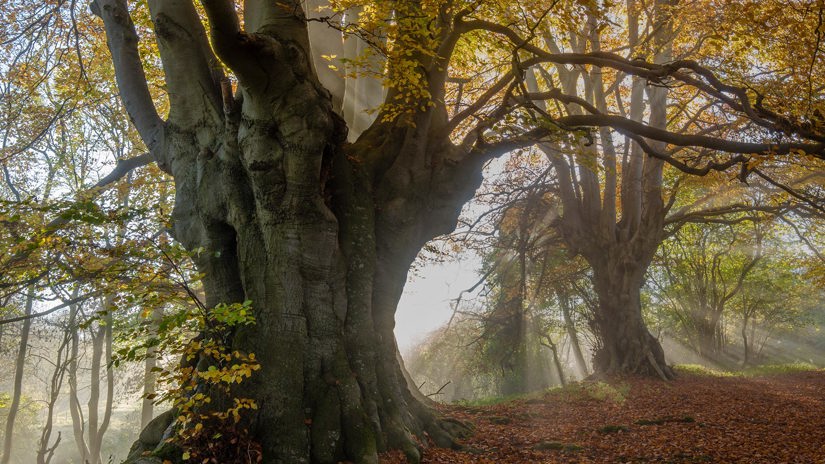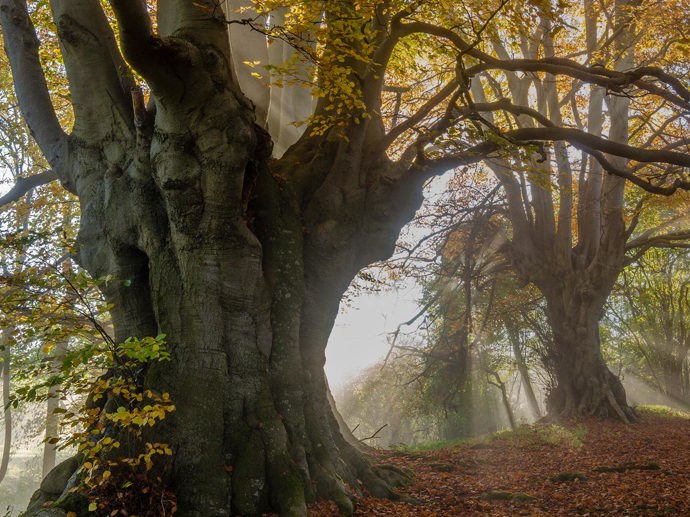Common name: Blue ground beetle
Scientific name: Carabus intricatus
Family: Carabidae
Habitat: damp and often ancient deciduous woods
Diet: slugs
Predators: birds, mammals
Origin: native
Rare jewel. Treetop adventurer. The blue ground beetle is found at just a handful of sites in England and Wales, scaling trees under cover of darkness in search of slugs.
Common name: Blue ground beetle
Scientific name: Carabus intricatus
Family: Carabidae
Habitat: damp and often ancient deciduous woods
Diet: slugs
Predators: birds, mammals
Origin: native
Adults: are the UK’s largest species of ground beetle, measuring in at up to an impressive 38mm long. They have strong, pincer-like jaws, long legs, and are a stunning metallic blue colour.
Larvae: are rarely seen and have only been found on a handful of occasions in the UK. They have a long, black, segmented body, and ferocious pincers that are perfect for biting into slugs.
Adult blue ground beetles and their larvae both eat slugs, particularly the tree slug (Limax marginatus) and the ash–black slug (Limax cinereoniger). They’ll follow a slug’s slime trail – often into the trees – then, once they make contact, grab hold of their prey with their pincers and inject digestive juices that turn the innards into a slug smoothie.

Credit: Andrew Merrick / Alamy Stock Photo
Blue ground beetles mate and lay eggs in spring, usually in soil or organic matter. The eggs hatch shortly after, and the larvae develop quickly through the summer. The larvae then pupate, and the next generation of adult blue ground beetles usually emerges around August and September.
Despite having wing cases, blue ground beetles don’t have wings and so can’t fly.
The blue ground beetle was considered extinct in the UK until 1994. Since then, it’s been rediscovered at just 15 sites across Cornwall, Devon and South Wales. Blue ground beetles live in damp, deciduous woodlands of oak and beech trees – specifically on south-facing slopes with sparse ground vegetation and plenty of ancient or veteran trees and dead wood.

Credit: Ralph Martin / Alamy Stock Photo
Being so rare and specialised, blue ground beetles are hard to spot! They’re also nocturnal and most likely seen climbing tree trunks after dark in search of slugs. They’re most active between March and June. In winter, they tend to tuck themselves away inside dead wood, nestling beneath bark or moss or inside the moist, rotting heart of a dead tree trunk.
Blue ground beetles can sometimes be confused with the much more common violet ground beetle. This beetle is smaller, and its jewel-like colouring has a distinctive purple sheen. Unlike the blue ground beetle, it's found in a range of habitats right across the UK, from woodlands to moorland and even some urban areas.
The blue ground beetle can squirt acid from its abdomen as a defence mechanism.
The biggest threat to the blue ground beetle is the loss of its ancient woodland habitat. Ancient woodland now covers just 2.5% of the UK – the rest has been destroyed by development, replanting with conifers, and neglect through lack of management. Sadly, the ancient woodland we have left is still at risk, but we’re doing all we can to protect and restore it.
We’ve also co-funded a piece of PhD research examining the foraging habits, habitat use and population characteristics of blue ground beetles on Dartmoor. The project used a range of tracking and mapping techniques to study the beetles and has already identified that we should be encouraging deadwood habitats in ancient woods if we’re to help them thrive.


Walk amongst giants. Picnic with rare wildlife. Step into a time machine. Use our wood finder and visit an ancient wood near you - all free to explore.